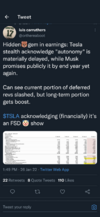delegated to the states (with guidelines and recommendations) [/URL]the approval process to be used but only for testing and pilot programs.
That's simply not true.
They HAVE made recommendations- but states are free to allow full commercial use of robotaxis however they want right now. Not just for pilot programs or testing.
And a number of states have done so.
If you wanna operate one RIGHT NOW you can, without needing any say-so from the feds.
They could certainly decide to do some regulation LATER- but that takes a while.
TODAY there's no such hoops for anyone to jump through if they want to put an RT on the road right now.
Florida for example passed this law several years ago:
Fully autonomous cars, including on-demand autonomous vehicle networks, legal in FL. Today. Commercially.
The only requirements are that it can follow all current motor vehicle laws and safety standards.
Follows any federal laws for autonomous cars (of which there ARE NONE today)
Can achieve minimal risk condition without a human (so L4 and above)
Here's Colorado:
Which explicitly allows full operation of L4 and L5 systems on public roads. Fully, not just for testing or pilot programs.
The ONLY requirement is the vehicle must comply with any state or federal law applicable to operation (and again there are no such federal laws today).
Here's Georgia:
2024 Georgia Autonomous Vehicle Laws for dummies. Quick reference for all Georgia car laws.

georgiacarlaws.com
Allows fully autonomous cars INCLUDING commercial operation. Slightly more restrictive in that it has specific insurance coverage requirements, but otherwise largely same story about it must otherwise comply with all existing laws, and be at least L4 (able to reach minimal risk condition without a human).
Here's Nebraska:
Specifically allows personal and commercial use of self driving cars- including on-demand vehicle networks. Only requirements? L4 or L5, and must follow all existing driving/safety laws...plus you must submit proof of insurance to the state. That's it.
Here's North Carolina:
SLIGHTLY more restrictive here- autonomous vehicles are allowed (for not just testing or pilots) but they can't carry anyone under 12 unless there's an adult present, and must be able to stop at a scene of a crash it's involved in. Otherwise same usual requirements as other states, must be insured, must follow all state/fed laws. But otherwise totally legally to operate em TODAY.
Here's Tennessee-
Justia Free Databases of US Laws, Codes & Statutes

law.justia.com
Pretty much same deal- must follow all laws, must be insured, can do minimal risk fallback task (so L4 or L5), and is registered specifically as an automated vehicle on the normal car registration.... if so you can operate it in the state TODAY. No limitations for pilots or testing.
Hopefully half a dozen examples are sufficient to establish Tesla can roll out robotaxis
any time they want in at least some US states without "waiting on regulators" to allow it.






